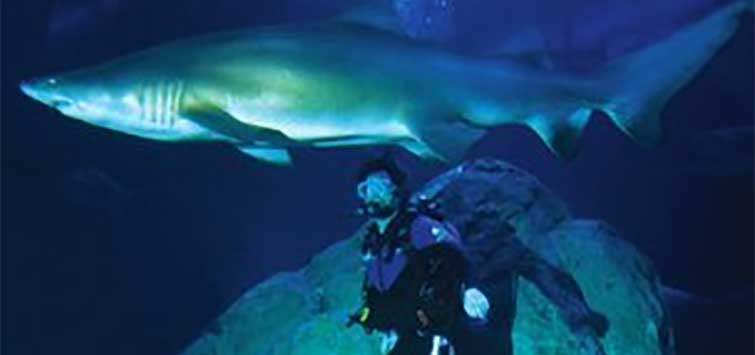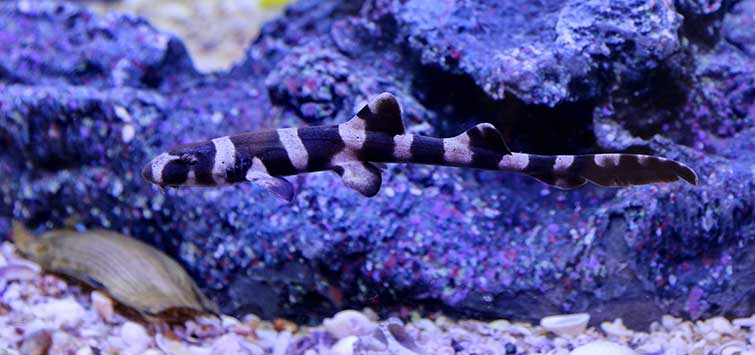Swimming With Sharks! TFH Dives Into the Adventure Aquarium
Author: Shari Horowitz
Cue the Jaws theme—TFH's President and Associate Editor each jump into two epic and breathtaking exhibits at the Adventure Aquarium on the Camden, New Jersey Waterfront to dive with some of the ocean's top predators. Follow their encounter with sand tiger, sandbar, nurse, and hammerhead sharks, as well as rays the size of a dinner table—and the brave fish that live with them.
Spectacular Sharks
Sharks captivate children and adults alike with their prominent teeth, sleek bodies, and graceful movements. Despite the dream of many aquarists to keep these fascinating animals in their own homes, the reality remains that their large size and specific care requirements make it virtually impossible to keep them in home aquaria. That’s where public aquaria come in, with their ever-increasing number of mega-displays that feature the tanks of many hobbyists’ dreams. But looking at a shark is one thing; for the ultimate fishkeeping experience you need to enter their watery world.
On an unseasonably warm day this March, the TFH team set out to do what most people spend their lives avoiding—jumping into a tank full of sharks! TFH’s own President and Executive Editor Glen Axelrod and I traveled to the Adventure Aquarium on the Camden, New Jersey Waterfront to participate in the aquarium’s Sharks Up-Close and Sea Life Up-Close Adventure Programs, where we were able to scuba dive in their two largest exhibits.
TFH’s Associate Advertising Director Blake Tedeschi and Associate Publisher/Managing Editor Albert Connelly, Jr. supervised from a safe, dry vantage point on the other side of the glass, where photographer and videographer Tamer Tewfik and his crew from Swamp Queen Productions photographed the action in the huge tanks. We participated in just two of the multiple Adventure programs the aquarium offers—a series of up-close animal experiences that allow guests to go behind the scenes with Adventure Aquarium biologists and learn more about the animals in a hands-on, interactive way.
Sharks Up-Close
Glen went first, diving into the Sharks Up-Close Adventure, where he entered a 550,000-gallon exhibit filled with 26 sharks, various groupers, and a variety of other fish. Glen is a well-seasoned scuba diver with years of experience, having logged over 1000 dives to date. He dove the African Rift Lakes to conduct research for his books and has participated in scuba dives all over the world, including the Gulf of Aqaba, the Red Sea, Kenya, Tanzania, Cayman Islands, and Bermuda, as well as numerous other locales (even New Jersey).
The Shark Realm Exhibit
On this particular dive he was in the Shark Realm exhibit, which primarily features three species of sharks—sand tiger sharks Carcharias taurus, sandbar sharks Carcharhinus plumbeus, and nurse sharks Ginglymostoma cirratum—and the green sawfish Pristis zijsron. Sawfish are commonly thought to be sharks, but they are actually more closely related to rays, stingrays, and guitarfish. Although 60 percent of the collection in Shark Realm was collected by aquarium staff, the two nurse sharks were donated by hobbyists who most likely underestimated their ultimate size and care requirements, Husbandry Director Marc Kind explained.
Before the dive, the Adventure Aquarium’s Dive Safety Officer, Tom Saylor, who guided both underwater adventurers, explained that the two green sawfish are to be given the most space and respect—because as they turn their bodies their toothed rostrums can injure anyone in their proximity. Luckily, the sawfish in the exhibit are typically uninterested in divers and tend to swim in the opposite direction.
After reviewing the Adventure Aquarium’s myriad safety procedures, Glen and Tom suited up. Since Glen has had experience diving deeper than 200 feet, the 22-foot maximum depth in the exhibit was nothing in comparison. The water is maintained at a relatively warm 71°F.
Diving In
“While the relatively warm water temperature of 71°F (22°C) was perfect for the 3 mm wet suit I was using, the opportunity to get this close to more than two dozen sharks was so exciting that water temperature wasn’t even on my radar,” Glen said. “Nevertheless, however exciting it was, care needed to be taken not to startle the animals in the tank with any sudden movements, and I kept in mind that I was the visitor in their world. And I certainly would not want to end up making contact with the sawfish’s rostrum. He has that ‘piece of hardware’ for a reason, and I wanted to avoid becoming a demonstration of its effectiveness.”
The two toured the perimeter of the exhibit, allowing the sharks an opportunity to get used to the visitors. Despite the pervasive view that sharks are vicious attack machines, the truth remains that both in the wild and in the aquarium, they tend to avoid divers and other humans.
Unlike in the wild, however, these sharks in Shark Realm often come closer after an acclimation period. Glen said, “Probably the most difficult part of the dive was trying to remain in a stationary place, mid-water, with neutral buoyancy so that the sharks would feel comfortable coming in for a closer look. I was something new in their environment, and their natural curiosity to check me out was also tempered by well-placed caution, as this was not the open ocean with escape routes.”
Aquarium Diving vs Open-Ocean Diving
There are also many other differences between diving in an aquarium enclosure and in the open-ocean setting, where the primary reason to slow down is for personal viewing pleasure; in the exhibit, every movement must be slow and deliberate to avoid unexpected encounters with animals or rocks. Also, the line of sight in the aquarium is very short in some places, and some passages are rather narrow.
“Aquarium tank diving is a very different experience from diving in the wild,” Glen advises. “To begin with, you are essentially guaranteed close encounters with the wildlife because you know they are there, and they essentially cannot escape. However, that also mandates that the diver gives extreme respect to his hosts in the tank, including right-of-way through the channel passages. Usually your deference for the fish and other animals in the aquarium is amply rewarded by encounters that are much closer than typically experienced in the wild.”
Sea Life Up-Close
After Glen completed his dive in Shark Realm, I was able to experience the Sea Life Up-Close Adventure, where I took a giant stride into a 760,000-gallon exhibit (large enough that it could hold five four-bedroom houses), which is home to a juvenile great hammerhead shark Sphyrna mokarran,blacktip shark Carcharhinus limbatus, blacknose shark Carcharhinus acronotus, roughtail stingrays Dasyatis centroura, a loggerhead sea turtle Caretta caretta, green sea turtles Chelonia mydas, and many schools of other fish.
The silky shark Carcharhinus falciformis is extremely rare in public aquaria, with the Adventure Aquarium being one of the only aquariums in the country to have one. The bowmouth guitarfish (also known as a shark ray) Rhina ancylostoma is another rarely kept species, but they are especially interesting to see in person, as no two individuals have the exact same patterning. Adventure Aquarium has three bowmouth guitarfish, two females and one male—their husbandry team is hopeful that they may eventually be able to breed them, which would be a first in an aquarium setting.
The Great Hammerhead
The great hammerhead, one of Marc’s favorite animals in the aquarium, was added last August. There were weeks of preparation beforehand in order to welcome and acclimate the animal, and a team remained in the water and topside with the shark (on rotating shifts) for approximately two and a half days to help the animal acclimate to its new surroundings, to ensure the other animals were adapting to their new exhibit-mate, and to be accessible should any emergent issues arise. The team even had a “crash cart” of chemotherapeutics ready to go and a staff veterinarian on-call. Fortunately, they were not needed.
“For me, personally, the great hammerhead shark symbolizes Adventure Aquarium’s mission and the reason our team of biologists remain dedicated to our animals and exhibits—to showcase beautiful, interesting, and amazing animals,” Marc said, adding that it is quite different to see them in person than it is to see them on television or in magazines. “Acquiring and acclimating our hammerhead was a challenge, almost like being a coach of a team who just won a big game, where the entire team was able to share in the accomplishment.”
The hammerhead was certainly beautiful, and it was not shy, as it approached me virtually from the start. The animals of Ocean Realm generally seemed unaffected by the presence of divers. The green sea turtle, in fact, remained close to me throughout the course of the dive and almost acted like it was posing for pictures. Ocean Realm has a much longer line of sight, with few large obstructions. Unlike Shark Realm, it has a sandy bottom for the rays to bury themselves in. It is an exhibit with constant activity, which meant that, as a diver, I was sometimes caught off guard because I was looking in one direction and something was coming from the other side. It made for some interesting photos and funny moments (and yes, you can laugh into a regulator).
Swim With the Sharks
Being that rays are my favorite animal, I additionally had the opportunity to participate in the second half of the Swim With the Sharks Adventure—the most popular Adventure, it allows non-scuba certified guests the opportunity to snorkel with sharks. The experience also includes an opportunity to feed small stingrays in Stingray Lagoon, a small, sandy pool adjacent to Shark Realm. The pool serves as a home to cownose rays Rhinoptera bonasus, leopard whiprays Himantura undulata, southern stingrays Dasyatis americana, Atlantic stingrays Dasyatis sabina, and several species of juvenile fish.
The rays are fed a variety of foods, including pieces of mackerel and squid. Tom showed me that to feed them, a piece of food should be placed between two fingers and loosely held under water, wiggling a little to attract them to it. Before we even got into the pool, the rays anticipated being fed and were clapping their wings on the rock ledge to get our attention. In doing so, they actually postponed their own mealtime because there was no clear spot for us to enter the water without stepping on one of the little beggars.
Immediately upon my entering the shallow water, the rays swarmed and started eating as soon as possible. At one point, while I was holding a rather large piece of squid and not looking down at the animals, an impertinent juvenile French angelfish Pomacanthus paru flattened its body horizontally to mimic the rays and grabbed the food—which was clearly larger than its head—out of my fingers. The rays were quite proficient at accepting food, and they seemed to enjoy the experience as much as I did.
Care and Nourishment
Spending time with the sharks and rays might have been a fun activity for Glen and me, but it is hard work for Marc, Tom, and the Adventure Aquarium’s team of biologists.
Feeding the sharks is perhaps the most difficult, though probably the most interesting, part of their husbandry. The biggest challenge when keeping sharks in aquaria, according to Marc, is preventing them from becoming overweight. Although most people see sharks as relentless predators, the truth is that a shark in the wild is opportunistic and may only have one big feeding a week (if that much).
The sharks in the Adventure Aquarium are fed three times weekly, 2 to 3 percent of their total body weight, and a vitamin supplement is added to the food once a week. All biologists are trained to be able to identify every individual shark both from the top and the viewing window, and during feedings a record is kept of exactly how much food each animal receives. The biologists use a long feeding pole in order to feed them, as sharks can obviously become quite aggressive at feeding time.
Shark Care 101
All of the sharks and larger animals at the aquarium are given annual physical exams and are constantly observed by thebiologists and veterinary staff. Divers are in theexhibits on a daily basis. There are two veterinarians who stagger their schedules so a doctor is always on hand if needed.
Another difficulty in keeping predators is managing aggression in theexhibits. Sometimes the biologists on staff will come in the morning and find puncture wounds from bites during the night. Recently, the last barracuda in the shark exhibit was eaten by its exhibit mates. Marc said that, just like in the wild, if an animal is taken out by another animal in an exhibit, it is most likely because they are sick, injured, or old, which ultimately aids in keeping a healthy population going. However, there is little predation in the exhibit.
Further Adventures
If sharks are not your thing, the Seals Up-Close Adventure allows guests, alongside a biologist, to participate in a training session with the aquarium’s gray and harbor seals. The program allows you to help feed them, help train them, and even participate in a live seal show. The techniques learned from the training can be used on pets kept at home as well.
The newly added Positively Penguin Adventure allows guests behind the scenes at the Penguin Island exhibit to learn how the penguins interact with the biologists and how they are fed and trained. They can also participate in enrichment (play) sessions with the penguins. Guests can even touch a penguin during a mock physical penguin exam, and get a photo with their new penguin pal.
Lastly, Secrets of Africa takes visitors on a journey to meet another impressive animal—the hippo. This Adventure, which occurs in the Aquarium’s West African River Experience exhibit, allows for the viewing of the hippo night quarters and their husbandry training. Guests also spend time hand-feeding exotic birds and interacting with an African porcupine.
Not for the Home Aquarium
Despite many hobbyists’ understandable fascination with sharks and other large aquatic animals, their keeping is best left to the professionals. Marc specifically recommends against any hobbyist keeping marine sharks or any species of stingray—even freshwater species can grow to the size of a trashcan lid and have special requirements few if any home aquariums can meet. Furthermore, the aquarium is contacted almost weekly by hobbyists who have animals that have outgrown their enclosure, and they are rarely able to accept these unfortunate specimens.
Aside from size, they can be difficult and finicky feeders (despite common perceptions), which can lead to health issues. Force-feeding a top predator is not an easy thing to do. Other health issues—abraded rostrums, illness, and malnutrition—all need to be addressed by professionals trained in elasmobranch biology. In captivity outside of public aquariums, most sharks and rays exhibit stunted growth, so Marc questions if their keepers are really doing what is in the animals’ best interest.
Sharks and rays are intelligent, fascinating, beautiful, and mysterious creatures that are ideally viewed in the wild or the more accessible public aquaria. We at TFH were very grateful for the opportunity to visit them in their world.
Acknowledgements
TFH would like to thank Kimberly Walker, Nikki Grandinetti, Ashley Hartness, Ray Popik, Jeff Leopold, and Terry Jerome as well as the rest of the Adventure Aquarium staff who helped us in this adventure, and also Tamer Tewfik, Jordan Oplinger, Lucy Draus, and production assistant Mike Gorczynski of SQ Productions for their masterful visual documentary of the day’s events.
Be sure to check out video coverage of Glen’s and Shari’s shark dives at Adventure Aquarium!
The Adventure Aquarium
1 Riverside Drive, Camden, NJ 08103
Open: Daily 9:30 a.m. to 5:00 p.m.
www.adventureaquarium.com
(856) 365-3300 x 7540 to book an Adventure
See the full article on TFH Digital http://www.tfhdigital.com/tfh/200906/#pg79

.png?h=595&iar=0&w=2781&hash=5FD5E69473BCC22199FBFA2FB71B6033)



